2,5-Dihydroxybenzoic Acid Ameliorates Metabolic Dysfunction-Associated Steatotic Liver Disease by Targeting the CCL2-CCR2 Axis to Reduce Lipid Accumulation
Abstract
1. Introduction
2. Materials and Methods
2.1. Chemicals
2.2. Cell Culture and OA-Induced Cell Model
2.3. Cell Viability Assay
2.4. Oil Red O Staining
2.5. MASLD Animal Experiment
2.6. RNA-Seq and Pathway Analysis
2.7. Molecular Docking Analysis of CCR2 and 2,5-DHBA
2.8. Histopathological Examination and IHC Staining Analysis
2.9. Statistical Analysis
3. Results
3.1. 2,5-DHBA Reduced OA-Induced Lipid Accumulation in Hepatocytes
3.2. 2,5-DHBA Ameliorated HFD-Induced Hepatic Lipid Accumulation in Mice
3.3. Transcriptomic Analysis of 2,5-DHBA-Regulated Gene Expression in MASLD Livers
3.4. 2,5-DHBA Competes with CCL2 for Binding to CCR2
3.5. 2,5-DHBA Reduces CCL2 Expression, Nuclear Factor-κB (NF-κB) Activation, and Inflammatory Cell Infiltration in MASLD Mouse Livers
4. Discussion
5. Conclusions
Author Contributions
Funding
Institutional Review Board Statement
Informed Consent Statement
Data Availability Statement
Conflicts of Interest
Abbreviations
| CCK-8 | Cell Counting Kit-8 |
| CCL2 | Chemokine (C-C motif) ligand 2 |
| CCR2 | Chemokine (C-C motif) receptor 2 |
| Cxcl10 | C-X-C motif ligand 10 |
| DEGs | Differentially expressed genes |
| 2,5-DHBA | 2,5-Dihydroxybenzoic acid |
| DIRECT PLUS | Dietary Intervention Randomized Controlled Trial Polyphenols Unprocessed |
| DMEM | Dulbecco’s modified Eagle’s medium |
| DMSO | Dimethyl sulfoxide |
| H&E | Hematoxylin and eosin |
| HFD | High-fat diet |
| IHC | Immunohistochemical |
| IL-1 | Interleukin-1 |
| KEGG | Kyoto Encyclopedia of Genes and Genomes |
| LD50 | Lethal dose at 50% |
| MASLD | Metabolic dysfunction-associated steatotic liver disease |
| NF-κB | Nuclear Factor-κB |
| OD | Optical density |
| PBS | Phosphate-buffered saline |
| PPARs | Peroxisome proliferator-activated receptors |
| RNA-Seq | RNA sequencing |
| TNF-α | Tumor necrosis factor-α |
References
- Hagström, H.; Shang, Y.; Hegmar, H.; Nasr, P. Natural history and progression of metabolic dysfunction-associated steatotic liver disease. Lancet Gastroenterol. Hepatol. 2024, 9, 944–956. [Google Scholar] [CrossRef]
- Huang, D.Q.; Wong, V.W.S.; Rinella, M.E.; Boursier, J.; Lazarus, J.V.; Yki-Järvinen, H.; Loomba, R. Metabolic dysfunction-associated steatotic liver disease in adults. Nat. Rev. Dis. Primers 2025, 11, 14. [Google Scholar] [CrossRef] [PubMed]
- Younossi, Z.M.; Golabi, P.; Paik, J.M.; Henry, A.; Van Dongen, C.; Henry, L. The global epidemiology of nonalcoholic fatty liver disease (NAFLD) and nonalcoholic steatohepatitis (NASH): A systematic review. Hepatology 2023, 77, 1335–1347. [Google Scholar] [CrossRef] [PubMed]
- Jurek, J.M.; Zablocka-Sowinska, K.; Clavero Mestres, H.; Reyes Gutiérrez, L.; Camaron, J.; Auguet, T. The impact of dietary interventions on metabolic outcomes in metabolic dysfunction-associated steatotic liver disease (MASLD) and comorbid conditions, including obesity and type 2 diabetes. Nutrients 2025, 17, 1257. [Google Scholar] [CrossRef]
- Semmler, G.; Datz, C.; Trauner, M. Eating, diet, and nutrition for the treatment of non-alcoholic fatty liver disease. Clin. Mol. Hepatol. 2023, 29, S244–S260. [Google Scholar] [CrossRef]
- Das, A.; Tang, Y.L.M.; Althumiri, N.A.; Garcia-Larsen, V.; Schattenberg, J.M.; Alqahtani, S.A. Fatty acid composition but not quantity is an important indicator of non-alcoholic fatty liver disease: A systematic review. Eur. J. Clin. Nutr. 2023, 77, 1113–1129. [Google Scholar] [CrossRef] [PubMed]
- Liu, Z.; Huang, H.; Zeng, Y.; Chen, Y.; Xu, C. Association between ultra-processed foods consumption and risk of non-alcoholic fatty liver disease: A population-based analysis of NHANES 2011-2018. Br. J. Nutr. 2023, 130, 996–1004. [Google Scholar] [CrossRef]
- Mercurio, G.; Giacco, A.; Scopigno, N.; Vigliotti, M.; Goglia, F.; Cioffi, F.; Silvestri, E. Mitochondria at the crossroads: Linking the Mediterranean diet to metabolic health and non-pharmacological approaches to NAFLD. Nutrients 2025, 17, 1214. [Google Scholar] [CrossRef]
- Sualeheen, A.; Tan, S.Y.; Georgousopoulou, E.; Daly, R.M.; Tierney, A.C.; Roberts, S.K.; George, E.S. Mediterranean diet for the management of metabolic dysfunction-associated steatotic liver disease in non-Mediterranean, Western countries: What’s known and what’s needed? Nutr. Bull. 2024, 49, 444–462. [Google Scholar] [CrossRef]
- Xiong, Y.; Shi, X.; Xiong, X.; Li, S.; Zhao, H.; Song, H.; Wang, J.; Zhang, L.; You, S.; Ji, G.; et al. A systematic review and meta-analysis of randomized controlled trials: Effects of mediterranean diet and low-fat diet on liver enzymes and liver fat content of NAFLD. Food Funct. 2024, 15, 8248–8257. [Google Scholar] [CrossRef]
- Berisha, H.; Hattab, R.; Comi, L.; Giglione, C.; Migliaccio, S.; Magni, P. Nutrition and lifestyle interventions in managing dyslipidemia and cardiometabolic risk. Nutrients 2025, 17, 776. [Google Scholar] [CrossRef] [PubMed]
- Bonofiglio, D. Effects of Mediterranean diet on chronic degenerative diseases and human healthy lifestyle. Nutrients 2025, 17, 1231. [Google Scholar] [CrossRef] [PubMed]
- Mellemkjær, A.; Kjær, M.B.; Haldrup, D.; Grønbæk, H.; Thomsen, K.L. Management of cardiovascular risk in patients with metabolic dysfunction-associated steatotic liver disease. Eur. J. Intern. Med. 2024, 122, 28–34. [Google Scholar] [CrossRef]
- Chooi, Y.C.; Zhang, Q.A.; Magkos, F.; Ng, M.; Michael, N.; Wu, X.; Volchanskaya, V.S.B.; Lai, X.; Wanjaya, E.R.; Elejalde, U.; et al. Effect of an Asian-adapted Mediterranean diet and pentadecanoic acid on fatty liver disease: The TANGO randomized controlled trial. Am. J. Clin. Nutr. 2024, 119, 788–799. [Google Scholar] [CrossRef]
- Kontogianni, M.D.; Tileli, N.; Margariti, A.; Georgoulis, M.; Deutsch, M.; Tiniakos, D.; Fragopoulou, E.; Zafiropoulou, R.; Manios, Y.; Papatheodoridis, G. Adherence to the Mediterranean diet is associated with the severity of non-alcoholic fatty liver disease. Clin. Nutr. 2014, 33, 678–683. [Google Scholar] [CrossRef] [PubMed]
- Yaskolka Meir, A.; Rinott, E.; Tsaban, G.; Zelicha, H.; Kaplan, A.; Rosen, P.; Shelef, I.; Youngster, I.; Shalev, A.; Blüher, M.; et al. Effect of green-Mediterranean diet on intrahepatic fat: The DIRECT PLUS randomised controlled trial. Gut 2021, 70, 2085–2095. [Google Scholar] [CrossRef]
- Abedi, F.; Razavi, B.M.; Hosseinzadeh, H. A review on gentisic acid as a plant derived phenolic acid and metabolite of aspirin: Comprehensive pharmacology, toxicology, and some pharmaceutical aspects. Phytother. Res. 2020, 34, 729–741. [Google Scholar] [CrossRef]
- Han, X.; Guo, J.; Gao, Y.; Zhan, J.; You, Y.; Huang, W. Gentisic acid prevents diet-induced obesity in mice by accelerating the thermogenesis of brown adipose tissue. Food Funct. 2021, 12, 1262–1270. [Google Scholar] [CrossRef]
- Liao, P.Y.; Lo, H.Y.; Liu, I.C.; Lo, L.C.; Hsiang, C.Y.; Ho, T.Y. A gastro-resistant peptide from Momordica charantia improves diabetic nephropathy in db/db mice via its novel reno-protective and anti-inflammatory activities. Food Funct. 2022, 13, 1822–1833. [Google Scholar] [CrossRef]
- Zhou, G.; Soufan, O.; Ewald, J.; Hancock, R.E.W.; Basu, N.; Xia, J. NetworkAnalyst 3.0: A visual analytics platform for comprehensive gene expression profiling and meta-analysis. Nucleic Acids Res. 2019, 47, W234–W241. [Google Scholar] [CrossRef]
- Schneidman-Duhovny, D.; Inbar, Y.; Nussinov, R.; Wolfson, H.J. PatchDock and SymmDock: Servers for rigid and symmetric docking. Nucleic Acids Res. 2005, 33, W363–W367. [Google Scholar] [CrossRef] [PubMed]
- Sterling, T.; Irwin, J.J. ZINC 15-ligand discovery for everyone. J. Chem. Inf. Model. 2015, 55, 2324–2337. [Google Scholar] [CrossRef]
- Meng, E.C.; Goddard, T.D.; Pettersen, E.F.; Couch, G.S.; Pearson, Z.J.; Morris, J.H.; Ferrin, T.E. UCSF ChimeraX: Tools for structure building and analysis. Protein Sci. 2023, 32, e4792. [Google Scholar] [CrossRef]
- Li, J.; Wang, T.; Liu, P.; Yang, F.; Wang, X.; Zheng, W.; Sun, W. Hesperetin ameliorates hepatic oxidative stress and inflammation via the PI3K/AKT-Nrf2-ARE pathway in oleic acid-induced HepG2 cells and a rat model of high-fat diet-induced NAFLD. Food Funct. 2021, 12, 3898–3918. [Google Scholar] [CrossRef] [PubMed]
- Fabinyi-Szebehely, M.; Hahn, L.; Szebehely, J. Investigation in vivo of new inhibitors of hyaluronidase. Br. J. Pharmacol. Chemother. 1953, 8, 30–33. [Google Scholar] [CrossRef]
- Hebbard, L.; George, J. Animal models of nonalcoholic fatty liver disease. Nat. Rev. Gastroenterol. Hepatol. 2011, 8, 35–44. [Google Scholar] [CrossRef] [PubMed]
- Caldwell, S.; Ikura, Y.; Dias, D.; Isomoto, K.; Yabu, A.; Moskaluk, C.; Pramoonjago, P.; Simmons, W.; Scruggs, H.; Rosenbaum, N.; et al. Hepatocellular ballooning in NASH. J. Hepatol. 2010, 53, 719–723. [Google Scholar] [CrossRef]
- Rafaqat, S.; Gluscevic, S.; Mercantepe, F.; Rafaqat, S.; Klisic, A. Interleukins: Pathogenesis in non-alcoholic fatty liver disease. Metabolites 2024, 14, 153. [Google Scholar] [CrossRef]
- Shao, Z.; Tan, Y.; Shen, Q.; Hou, L.; Yao, B.; Qin, J.; Xu, P.; Mao, C.; Chen, L.N.; Zhang, H.; et al. Molecular insights into ligand recognition and activation of chemokine receptors CCR2 and CCR3. Cell Discov. 2022, 8, 44. [Google Scholar] [CrossRef]
- Nagata, N.; Chen, G.; Xu, L.; Ando, H. An update on the chemokine system in the development of NAFLD. Medicina 2022, 58, 761. [Google Scholar] [CrossRef]
- Pan, X.; Chiwanda Kaminga, A.; Liu, A.; Wen, S.W.; Chen, J.; Luo, J. Chemokines in non-alcoholic fatty liver disease: A systematic review and network meta-analysis. Front. Immunol. 2020, 11, 1802. [Google Scholar] [CrossRef]
- Roh, Y.S.; Seki, E. Chemokines and chemokine receptors in the development of NAFLD. Adv. Exp. Med. Biol. 2018, 1061, 45–53. [Google Scholar] [PubMed]
- Steinberg, G.R.; Valvano, C.M.; De Nardo, W.; Watt, M.J. Integrative metabolism in MASLD and MASH: Pathophysiology and emerging mechanisms. J. Hepatol. 2025; in press. [Google Scholar] [CrossRef]
- Friedman, S.L.; Neuschwander-Tetri, B.A.; Rinella, M.; Sanyal, A.J. Mechanisms of NAFLD development and therapeutic strategies. Nat. Med. 2018, 24, 908–922. [Google Scholar] [CrossRef]
- Sun, J.; Jin, X.; Li, Y. Current strategies for nonalcoholic fatty liver disease treatment. Int. J. Mol. Med. 2024, 54, 88. [Google Scholar] [CrossRef]
- Tilg, H.; Byrne, C.D.; Targher, G. NASH drug treatment development: Challenges and lessons. Lancet Gastroenterol. Hepatol. 2023, 8, 943–954. [Google Scholar] [CrossRef] [PubMed]
- Wei, S.; Wang, L.; Evans, P.C.; Xu, S. NAFLD and NASH: Etiology, targets and emerging therapies. Drug Discov. Today 2024, 29, 103910. [Google Scholar] [CrossRef]
- Parker, R.; Weston, C.J.; Miao, Z.; Corbett, C.; Armstrong, M.J.; Ertl, L.; Ebsworth, K.; Walters, M.J.; Baumart, T.; Newland, D.; et al. CC chemokine receptor 2 promotes recruitment of myeloid cells associated with insulin resistance in nonalcoholic fatty liver disease. Am. J. Physiol. Gastrointest. Liver Physiol. 2018, 314, G483–G493. [Google Scholar] [CrossRef] [PubMed]
- Baeck, C.; Wehr, A.; Karlmark, K.R.; Heymann, F.; Vucur, M.; Gassler, N.; Huss, S.; Klussmann, S.; Eulberg, D.; Luedde, T.; et al. Pharmacological inhibition of the chemokine CCL2 (MCP-1) diminishes liver macrophage infiltration and steatohepatitis in chronic hepatic injury. Gut 2012, 61, 416–426. [Google Scholar] [CrossRef]
- Teng, K.Y.; Han, J.; Zhang, X.; Hsu, S.H.; He, S.; Wani, N.A.; Barajas, J.M.; Snyder, L.A.; Frankel, W.L.; Caligiuri, M.A.; et al. Blocking the CCL2-CCR2 axis using CCL2-neutralizing antibody is an effective therapy for hepatocellular cancer in a mouse model. Mol. Cancer Ther. 2017, 16, 312–322. [Google Scholar] [CrossRef]
- Lauszus, J.S.; Eriksen, P.L.; Hansen, M.M.; Eriksen, L.L.; Shawcross, D.L.; Vilstrup, H.; Thomsen, K.L.; Stoy, S. Activation and functional priming of blood neutrophils in non-alcoholic fatty liver disease increases in non-alcoholic steatohepatitis. Clin. Exp. Gastroenterol. 2021, 14, 441–449. [Google Scholar] [CrossRef]
- Tsompanaki, E.; Thanapirom, K.; Papatheodoridi, M.; Parikh, P.; Chotai de Lima, Y.; Tsochatzis, E.A. Systematic review and meta-analysis: The role of diet in the development of nonalcoholic fatty liver disease. Clin. Gastroenterol. Hepatol. 2023, 21, 1462–1474. [Google Scholar] [CrossRef] [PubMed]
- Comi, L.; Giglione, C.; Tolaj Klinaku, F.; Da Dalt, L.; Ullah, H.; Daglia, M.; Magni, P. Evaluation of metabolic dysfunction-associated fatty liver disease-related pathogenic mechanisms in human steatotic liver cell-based model: Beneficial effects of Prunus domestica L. subsp. syriaca extract. Nutrients 2025, 17, 1249. [Google Scholar] [CrossRef] [PubMed]
- Abe, T. Isoschaftoside in fig leaf tea alleviates nonalcoholic fatty liver disease in mice via the regulation of macrophage polarity. Nutrients 2025, 17, 757. [Google Scholar] [CrossRef]
- Kim, Y.J.; Park, S.; Kim, H.; Kim, S.R.; Jung, U.J. Myricitrin alleviates hypercholesterolemia and non-alcoholic fatty liver disease in high cholesterol diet-fed mice. Nutrients 2025, 17, 415. [Google Scholar] [CrossRef] [PubMed]
- Zuo, G.; Chen, M.; Zuo, Y.; Liu, F.; Yang, Y.; Li, J.; Zhou, X.; Li, M.; Huang, J.A.; Liu, Z.; et al. Tea polyphenol epigallocatechin gallate protects against nonalcoholic fatty liver disease and associated endotoxemia in rats via modulating gut microbiota dysbiosis and alleviating intestinal barrier dysfunction and related inflammation. J. Agric. Food Chem. 2024, 72, 9067–9086. [Google Scholar] [CrossRef] [PubMed]
- Shan, S.; Zhou, J.; Yin, R.; Zhang, L.; Shi, J.; Qiao, Q.; Li, Z. Millet bran protein hydrolysate displays the anti-non-alcoholic fatty liver disease effect via activating peroxisome proliferator-activated receptor γ to restrain fatty acid uptake. J. Agric. Food Chem. 2023, 71, 1628–1642. [Google Scholar] [CrossRef]
- Chiu, W.C.; Yang, H.H.; Chiang, S.C.; Chou, Y.X.; Yang, H.T. Auricularia polytricha aqueous extract supplementation decreases hepatic lipid accumulation and improves antioxidative status in animal model of nonalcoholic fatty liver. Biomedicine 2014, 4, 12. [Google Scholar] [CrossRef]
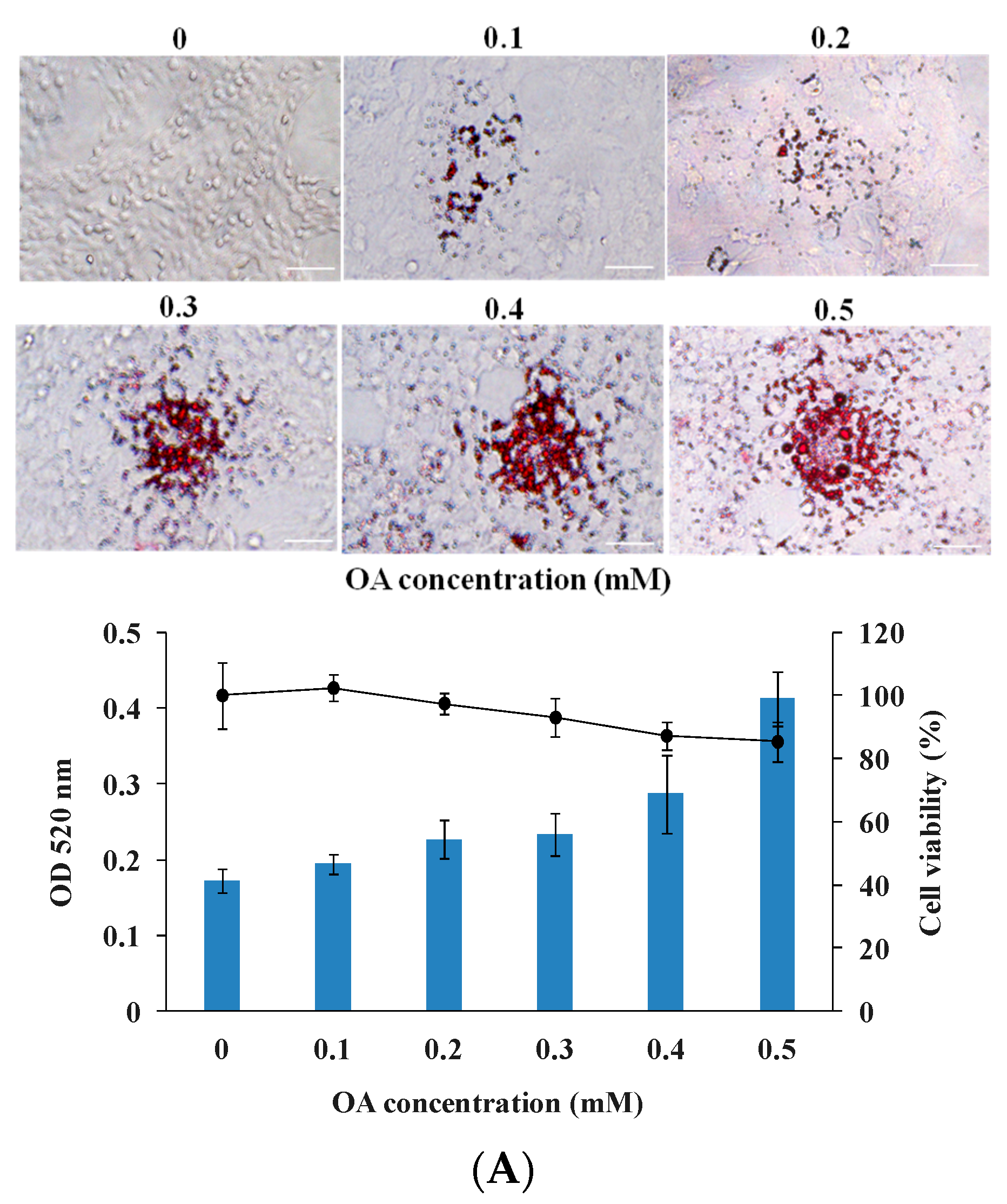
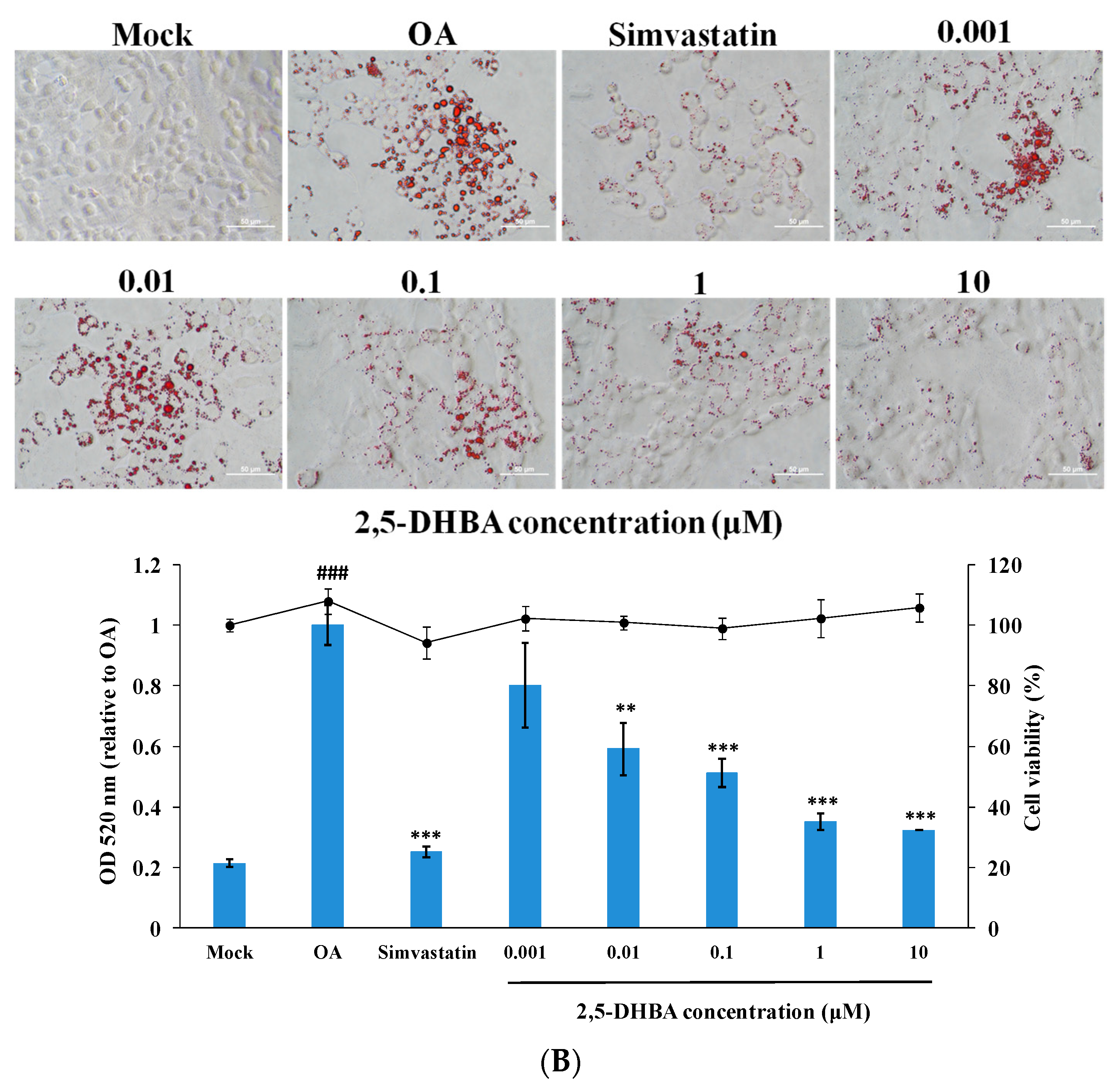
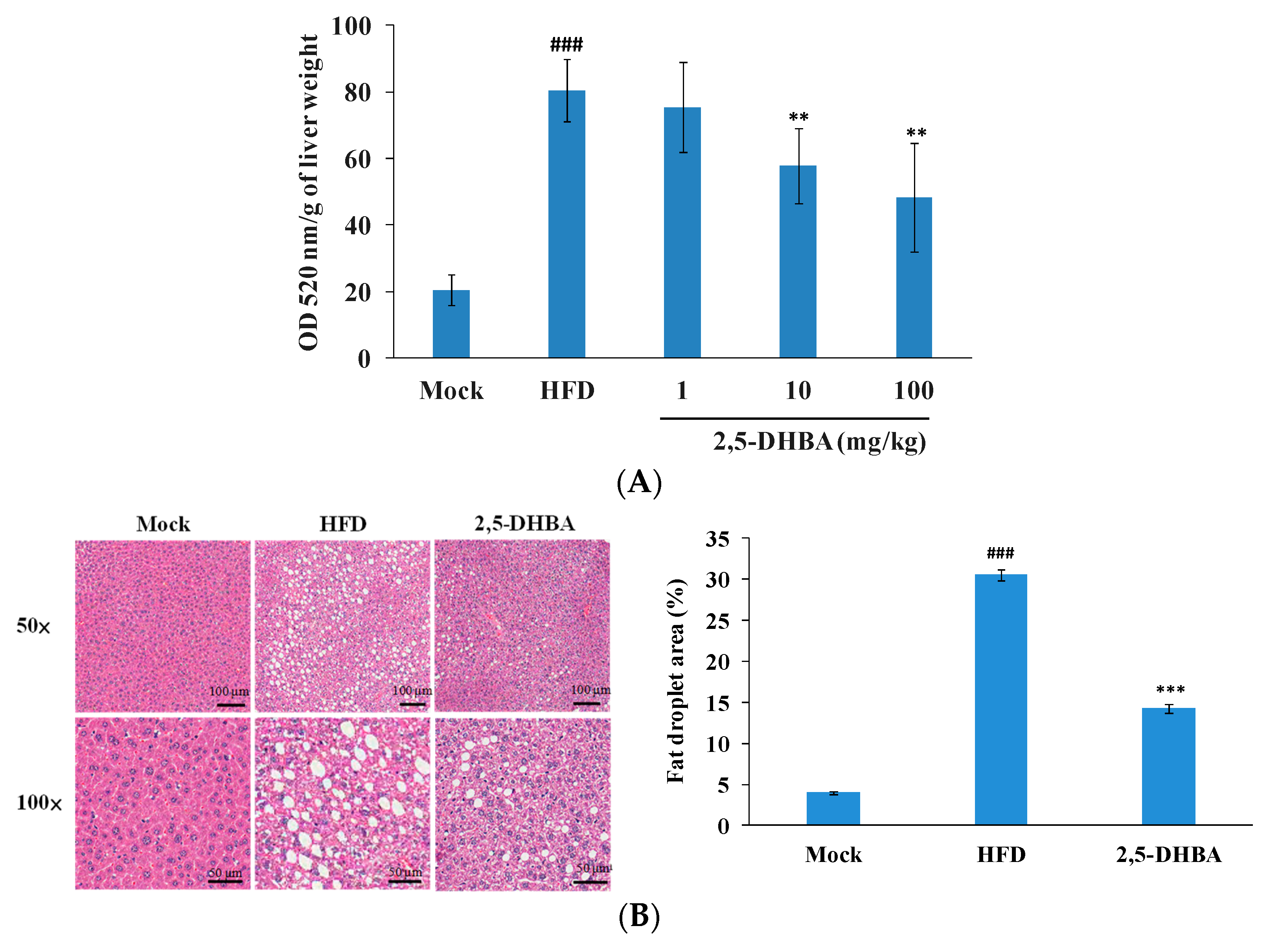
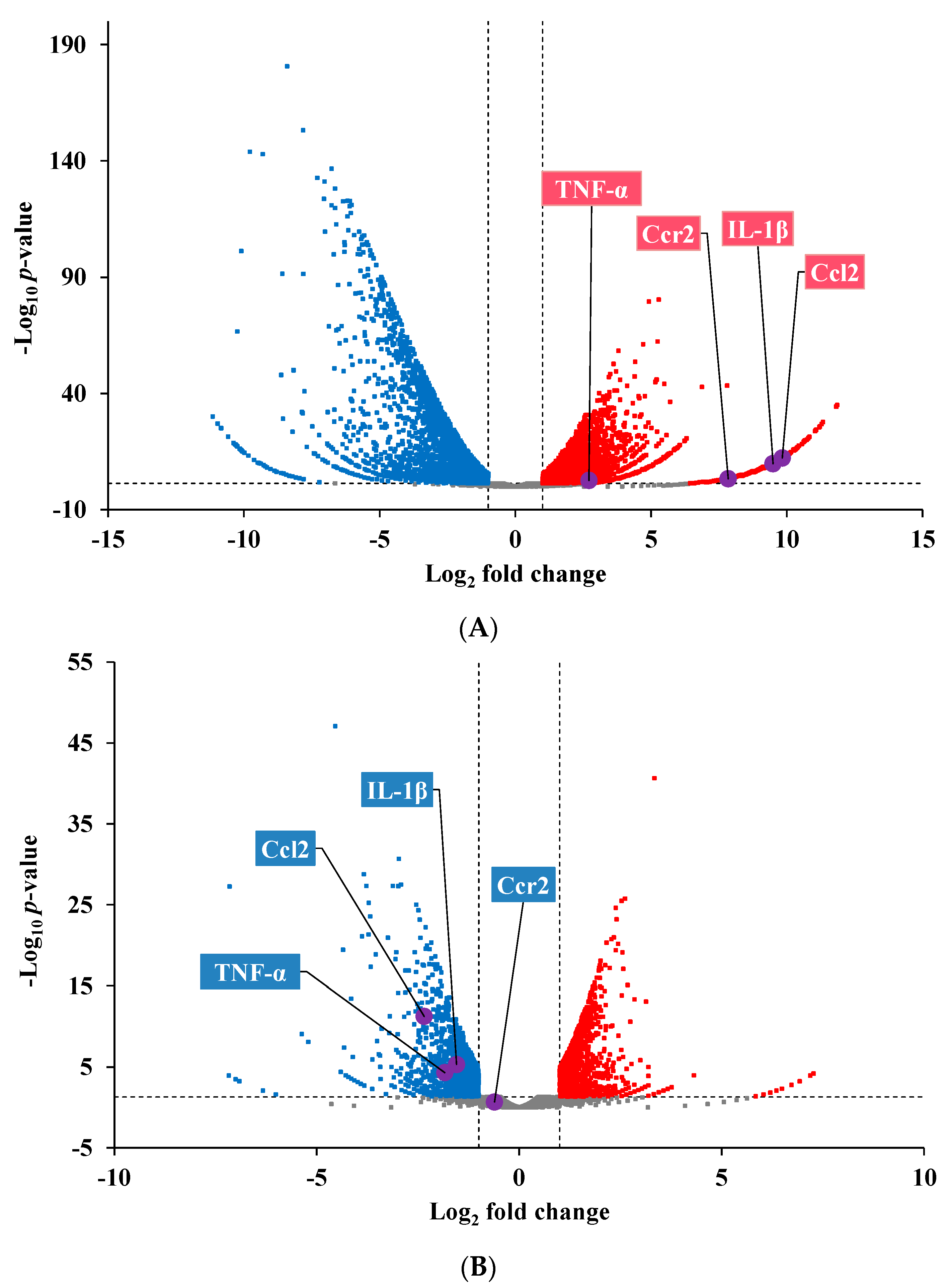
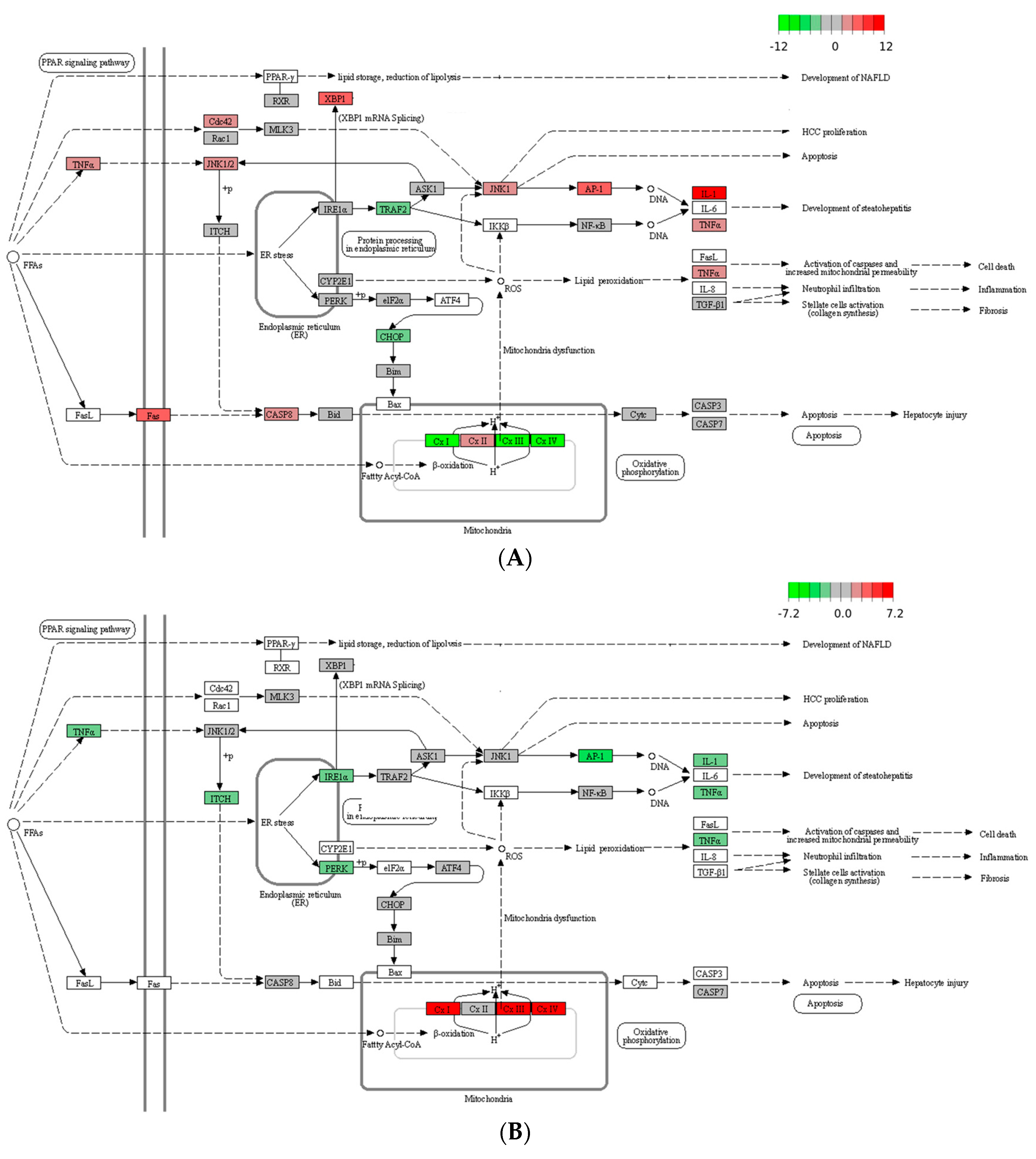
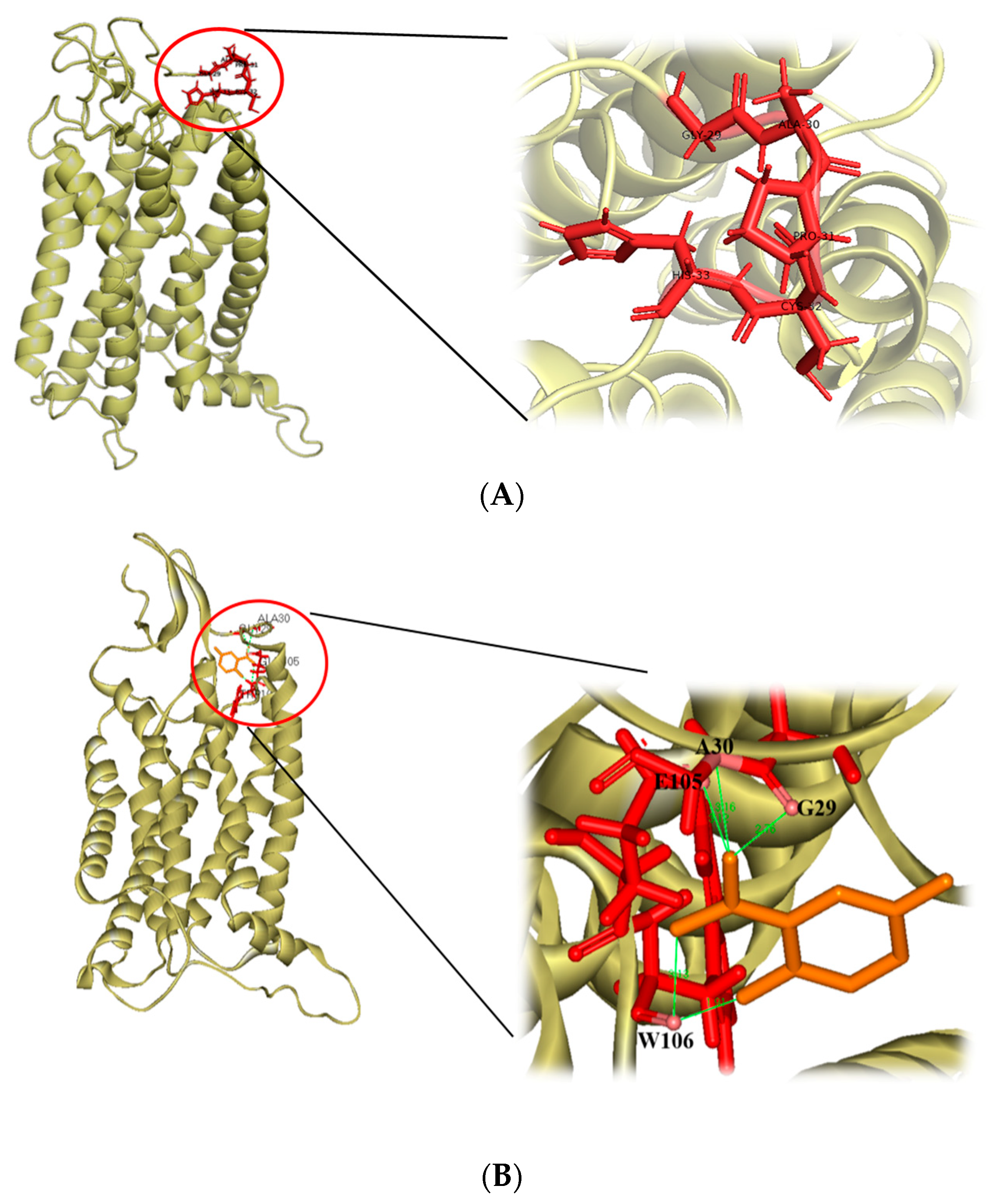
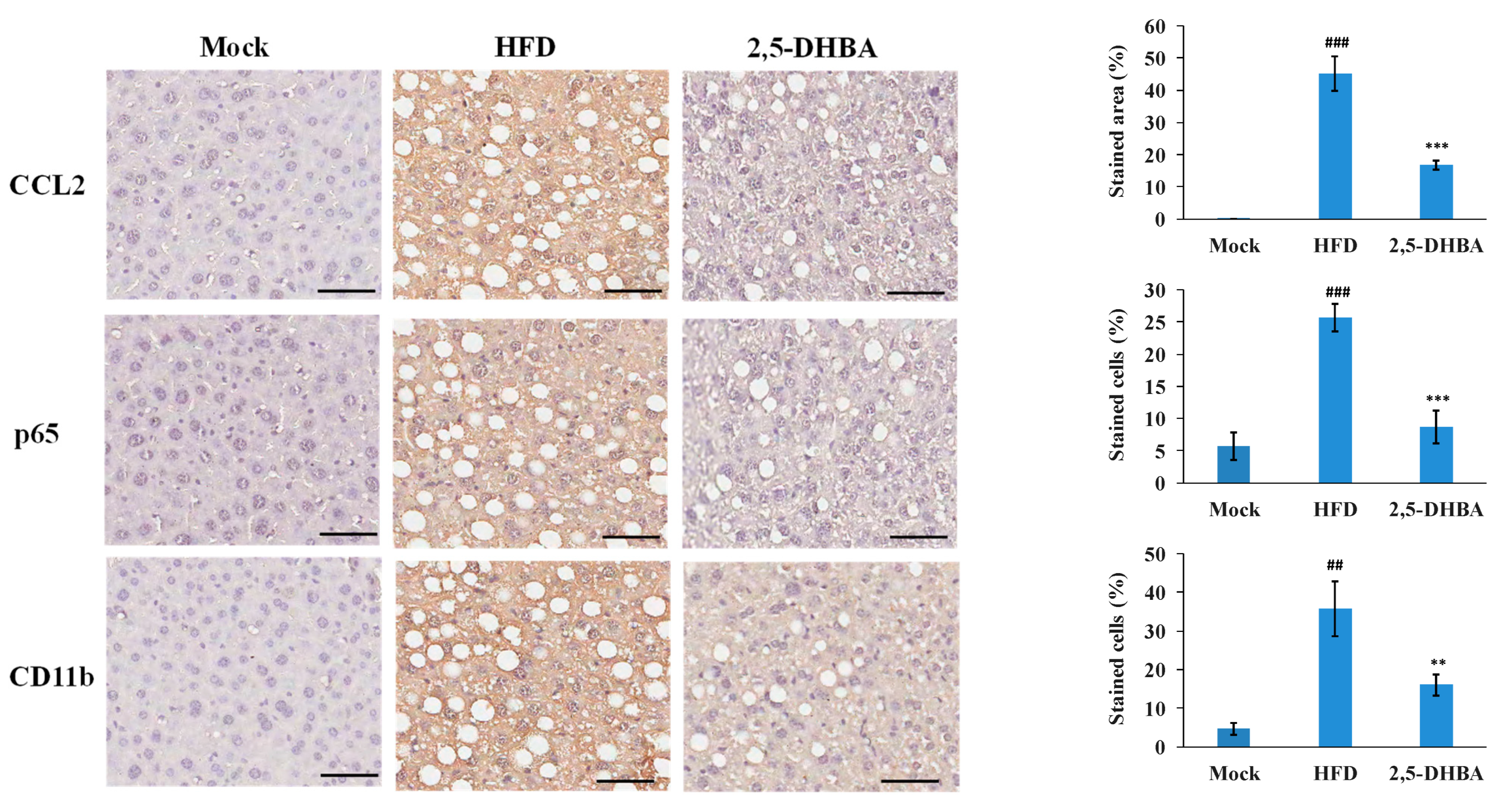
| HFD | 2,5-DHBA | p-Value | |
|---|---|---|---|
| Body weight gain (g) | 23.00 ± 2.69 | 27.86 ± 2.57 * | 0.022 |
| Food intake (g/day) | 2.60 ± 0.18 | 2.20 ± 0.34 | 0.086 |
| Calorie intake (kcal) | 13.26 ± 0.92 | 11.22 ± 1.76 | 0.086 |
| Liver weight (g) | 1.20 ± 0.25 | 1.36 ± 0.11 | 0.236 |
| Liver weight/body weight (%) | 5.20 ± 0.50 | 4.90 ± 0.20 | 0.266 |
| GOT (U/L) | 274.40 ± 98.38 | 243.60 ± 90.87 | 0.621 |
| Blood urea nitrogen (mg/dL) | 22.70 ± 3.06 | 20.34 ± 3.23 | 0.270 |
| Creatinine (mg/dL) | 0.46 ± 0.10 | 0.51 ± 0.04 | 0.294 |
| Cholesterol (mg/dL) | 117.60 ± 15.49 | 123.60 ± 13.46 | 0.532 |
| Triglyceride (mg/dL) | 125.80 ± 35.25 | 138.80 ± 28.31 | 0.538 |
| KEGG Pathway | Observed 1/Total 2 | p-Value |
|---|---|---|
| HFD-altered | ||
| Chemical carcinogenesis—reactive oxygen species | 167/175 | 1.64 × 10−26 |
| Oxidative phosphorylation | 105/224 | 5.82 × 10−19 |
| Thermogenesis | 157/188 | 1.05 × 10−17 |
| Non-alcoholic fatty liver disease | 114/127 | 7.90 × 10−17 |
| Protein processing in endoplasmic reticulum | 120/144 | 3.93 × 10−15 |
| Peroxisome | 69/74 | 3.98 × 10−14 |
| Biosynthesis of cofactors | 107/375 | 4.78 × 10−14 |
| Ubiquitin-mediated proteolysis | 97/133 | 2.59 × 10−10 |
| Carbon metabolism | 83/366 | 2.77 × 10−10 |
| Fluid shear stress and atherosclerosis | 94/99 | 5.75 × 10−9 |
| Proteasome | 38/49 | 1.59 × 10−8 |
| Spliceosome | 86/123 | 1.98 × 10−8 |
| Ribosome | 108/143 | 4.64 × 10−8 |
| Apoptosis | 86/110 | 5.46 × 10−8 |
| Autophagy—animal | 89/132 | 5.91 × 10−8 |
| 2,5-DHBA-altered | ||
| Ribosome | 109/143 | 4.07 × 10−24 |
| Chemical carcinogenesis—reactive oxygen species | 123/175 | 5.59 × 10−22 |
| Oxidative phosphorylation | 84/224 | 1.04 × 10−19 |
| Thermogenesis | 121/188 | 6.03 × 10−19 |
| Non-alcoholic fatty liver disease | 86/127 | 1.51 × 10−15 |
| Proteasome | 30/49 | 2.93 × 10−8 |
| mTOR signaling pathway | 70/117 | 1.11 × 10−7 |
| Chemical carcinogenesis—DNA adducts | 43/129 | 3.21 × 10−7 |
| Autophagy—animal | 63/132 | 5.89 × 10−7 |
| Biosynthesis of cofactors | 65/375 | 1.91 × 10−6 |
| Drug metabolism—other enzymes | 44/132 | 2.61 × 10−6 |
| Apoptosis | 59/110 | 3.24 × 10−6 |
| Protein processing in endoplasmic reticulum | 69/144 | 1.36 × 10−5 |
| TNF signaling pathway | 49/94 | 2.19 × 10−5 |
| Fluid shear stress and atherosclerosis | 60/99 | 2.66 × 10−5 |
| Symbol | Description | Fold Change | p-Value | |||
|---|---|---|---|---|---|---|
| HFD | 2,5-DHBA | HFD | 2,5-DHBA | |||
| Ccl2 | chemokine (C-C motif) ligand 2 | 912.556 | −5.086 | 9 × 10−14 | 8 × 10−14 | |
| Ccl3 | chemokine (C-C motif) ligand 3 | 158.494 | −5.344 | 0.0021 | 6 × 10−5 | |
| Ccl4 | chemokine (C-C motif) ligand 4 | 67.816 | −1.529 | 0.0158 | 0.4305 | |
| Ccl7 | chemokine (C-C motif) ligand 7 | 96.451 | −3.246 | 0.0246 | 0.0143 | |
| Ccl24 | chemokine (C-C motif) ligand 24 | −2.159 | 1.345 | 0.0031 | 0.1373 | |
| Ccl25 | chemokine (C-C motif) ligand 25 | −3.644 | −1.031 | 0.0018 | 1 | |
| Ccr1 | chemokine (C-C motif) receptor 1 | 96.451 | −2.791 | 0.0246 | 0.0277 | |
| Ccr2 | chemokine (C-C motif) receptor 2 | 230.082 | −1.528 | 2 × 10−4 | 0.1265 | |
| Ccrl2 | chemokine (C-C motif) receptor-like 2 | 5.131 | −1.901 | 0.0084 | 0.0189 | |
| Ccr5 | chemokine (C-C motif) receptor 5 | 1.596 | −1.833 | 0.2124 | 0.0085 | |
| Cx3cl1 | chemokine (C-X3-C motif) ligand 1 | 48.725 | 1.812 | 0.0226 | 0.0214 | |
| Cx3cr1 | chemokine (C-X3-C motif) receptor 1 | −2.328 | 2.013 | 0.0195 | 0.0105 | |
| Cxcl1 | chemokine (C-X-C motif) ligand 1 | 37.857 | −4.968 | 6 × 10−65 | 8 × 10−26 | |
| Cxcl2 | chemokine (C-X-C motif) ligand 2 | 273.035 | −6.946 | 3 × 10−5 | 3 × 10−8 | |
| Cxcl9 | chemokine (C-X-C motif) ligand 9 | 9.087 | −1.484 | 6 × 10−11 | 0.02157 | |
| Cxcl10 | chemokine (C-X-C motif) ligand 10 | 2344.319 | −2.635 | 2 × 10−27 | 6 × 10−9 | |
| Cxcl11 | chemokine (C-X-C motif) ligand 11 | 129.859 | 1.273 | 0.0096 | 0.5018 | |
| Cxcl12 | chemokine (C-X-C motif) ligand 12 | 2.676 | −1.387 | 2 × 10−10 | 0.0232 | |
| Cxcl13 | chemokine (C-X-C motif) ligand 13 | 1275.269 | −1.769 | 1 × 10−17 | 0.0012 | |
| Cxcl14 | chemokine (C-X-C motif) ligand 14 | 139.404 | −2.587 | 0.0057 | 0.0127 | |
| Cxcl16 | chemokine (C-X-C motif) ligand 16 | 2.159 | 1.094 | 0.0033 | 0.6099 | |
| Cxcr2 | chemokine (C-X-C motif) receptor 2 | 244.34 | −3.132 | 1 × 10−4 | 2 × 10−4 | |
| Cxcr4 | chemokine (C-X-C motif) receptor 4 | 63.043 | −1.166 | 0.0132 | 0.8477 | |
| Cxcr6 | chemokine (C-X-C motif) receptor 6 | 63.043 | −2.117 | 0.0132 | 0.0187 | |
Disclaimer/Publisher’s Note: The statements, opinions and data contained in all publications are solely those of the individual author(s) and contributor(s) and not of MDPI and/or the editor(s). MDPI and/or the editor(s) disclaim responsibility for any injury to people or property resulting from any ideas, methods, instructions or products referred to in the content. |
© 2025 by the authors. Licensee MDPI, Basel, Switzerland. This article is an open access article distributed under the terms and conditions of the Creative Commons Attribution (CC BY) license (https://creativecommons.org/licenses/by/4.0/).
Share and Cite
Hsiang, C.-Y.; Hsu, K.-T.; Lo, H.-Y.; Hou, Y.-J.; Ho, T.-Y. 2,5-Dihydroxybenzoic Acid Ameliorates Metabolic Dysfunction-Associated Steatotic Liver Disease by Targeting the CCL2-CCR2 Axis to Reduce Lipid Accumulation. Nutrients 2025, 17, 1835. https://doi.org/10.3390/nu17111835
Hsiang C-Y, Hsu K-T, Lo H-Y, Hou Y-J, Ho T-Y. 2,5-Dihydroxybenzoic Acid Ameliorates Metabolic Dysfunction-Associated Steatotic Liver Disease by Targeting the CCL2-CCR2 Axis to Reduce Lipid Accumulation. Nutrients. 2025; 17(11):1835. https://doi.org/10.3390/nu17111835
Chicago/Turabian StyleHsiang, Chien-Yun, Kuang-Ting Hsu, Hsin-Yi Lo, Yun-Jhu Hou, and Tin-Yun Ho. 2025. "2,5-Dihydroxybenzoic Acid Ameliorates Metabolic Dysfunction-Associated Steatotic Liver Disease by Targeting the CCL2-CCR2 Axis to Reduce Lipid Accumulation" Nutrients 17, no. 11: 1835. https://doi.org/10.3390/nu17111835
APA StyleHsiang, C.-Y., Hsu, K.-T., Lo, H.-Y., Hou, Y.-J., & Ho, T.-Y. (2025). 2,5-Dihydroxybenzoic Acid Ameliorates Metabolic Dysfunction-Associated Steatotic Liver Disease by Targeting the CCL2-CCR2 Axis to Reduce Lipid Accumulation. Nutrients, 17(11), 1835. https://doi.org/10.3390/nu17111835







